Anton van den Hengel
the University of Adelaide
Towards Higher Effective Rank in Parameter-efficient Fine-tuning using Khatri--Rao Product
Aug 01, 2025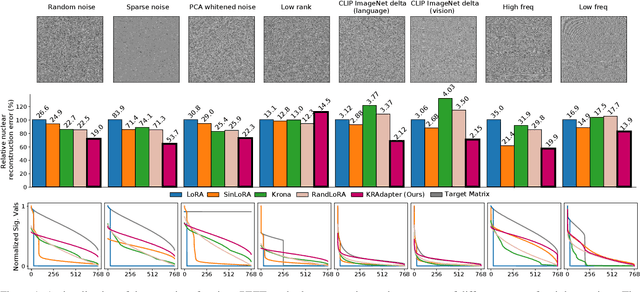
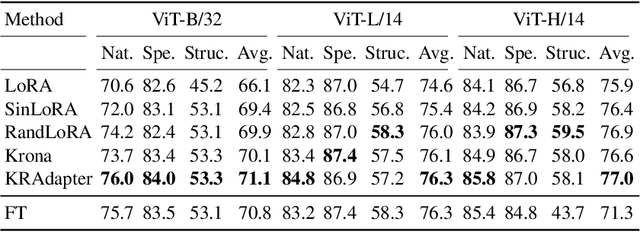

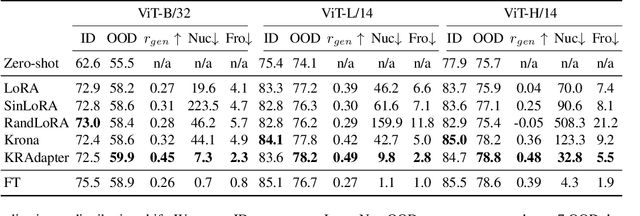
Abstract:Parameter-efficient fine-tuning (PEFT) has become a standard approach for adapting large pre-trained models. Amongst PEFT methods, low-rank adaptation (LoRA) has achieved notable success. However, recent studies have highlighted its limitations compared against full-rank alternatives, particularly when applied to multimodal and large language models. In this work, we present a quantitative comparison amongst full-rank and low-rank PEFT methods using a synthetic matrix approximation benchmark with controlled spectral properties. Our results confirm that LoRA struggles to approximate matrices with relatively flat spectrums or high frequency components -- signs of high effective ranks. To this end, we introduce KRAdapter, a novel PEFT algorithm that leverages the Khatri-Rao product to produce weight updates, which, by construction, tends to produce matrix product with a high effective rank. We demonstrate performance gains with KRAdapter on vision-language models up to 1B parameters and on large language models up to 8B parameters, particularly on unseen common-sense reasoning tasks. In addition, KRAdapter maintains the memory and compute efficiency of LoRA, making it a practical and robust alternative to fine-tune billion-scale parameter models.
Let Your Video Listen to Your Music!
Jun 23, 2025Abstract:Aligning the rhythm of visual motion in a video with a given music track is a practical need in multimedia production, yet remains an underexplored task in autonomous video editing. Effective alignment between motion and musical beats enhances viewer engagement and visual appeal, particularly in music videos, promotional content, and cinematic editing. Existing methods typically depend on labor-intensive manual cutting, speed adjustments, or heuristic-based editing techniques to achieve synchronization. While some generative models handle joint video and music generation, they often entangle the two modalities, limiting flexibility in aligning video to music beats while preserving the full visual content. In this paper, we propose a novel and efficient framework, termed MVAA (Music-Video Auto-Alignment), that automatically edits video to align with the rhythm of a given music track while preserving the original visual content. To enhance flexibility, we modularize the task into a two-step process in our MVAA: aligning motion keyframes with audio beats, followed by rhythm-aware video inpainting. Specifically, we first insert keyframes at timestamps aligned with musical beats, then use a frame-conditioned diffusion model to generate coherent intermediate frames, preserving the original video's semantic content. Since comprehensive test-time training can be time-consuming, we adopt a two-stage strategy: pretraining the inpainting module on a small video set to learn general motion priors, followed by rapid inference-time fine-tuning for video-specific adaptation. This hybrid approach enables adaptation within 10 minutes with one epoch on a single NVIDIA 4090 GPU using CogVideoX-5b-I2V as the backbone. Extensive experiments show that our approach can achieve high-quality beat alignment and visual smoothness.
Transformers Pretrained on Procedural Data Contain Modular Structures for Algorithmic Reasoning
May 28, 2025Abstract:Pretraining on large, semantically rich datasets is key for developing language models. Surprisingly, recent studies have shown that even synthetic data, generated procedurally through simple semantic-free algorithms, can yield some of the same benefits as natural language pretraining. It is unclear what specific capabilities such simple synthetic data instils in a model, where these capabilities reside in the architecture, and how they manifest within its weights. In this short paper, we identify several beneficial forms of procedural data, together with specific algorithmic reasoning skills that improve in small transformers. Our core finding is that different procedural rules instil distinct but complementary inductive structures in the model. With extensive ablations and partial-transfer experiments, we discover that these structures reside in different parts of the model. Attention layers often carry the most transferable information, but some pretraining rules impart useful structure to MLP blocks instead. Most interestingly, the structures induced by multiple rules can be composed to jointly reinforce multiple capabilities. These results suggest an exciting possibility of disentangling the acquisition of knowledge from reasoning in language models, with the goal of improving their robustness and data efficiency.
Continual Learning on CLIP via Incremental Prompt Tuning with Intrinsic Textual Anchors
May 27, 2025Abstract:Continual learning (CL) enables deep networks to acquire new knowledge while avoiding catastrophic forgetting. The powerful generalization ability of pre-trained models (PTMs), such as the Contrastive Language-Image Pre-training (CLIP) model, has inspired a range of CL methods targeting new and specialized tasks, providing rich multi-modal embeddings that support lightweight, incremental prompt tuning. Existing methods often rely on complex designs built upon specific assumptions, such as intricate regularization schemes for prompt pools, specialized routing mechanisms, or multi-stage incrementations, that introduce additional-and possibly unnecessary-complexity, underutilizing CLIP's intrinsic capabilities. In this paper, we propose a concise CL approach for CLIP based on incremental prompt tuning that fully exploits its multi-modal structure and the stability of textual representations. Our method, Textual Prototype-guided Prompt Tuning (TPPT), introduces textual prototypes not merely as static classifiers, as in existing methods, but as stable anchors to guide the learning of visual prompts, thereby shaping the embedding space (i.e., TPPT-V). We show that our bidirectional supervision strategy enables more effective learning of new knowledge while reducing forgetting. To further close the vision-language gap during CL, we jointly optimizes visual and textual prompts (i.e., TPPT-VT). We also introduce a relational diversity regularization on the textual anchors to prevent embedding space collapse and mitigate correlated forgetting. Extensive experiments and analyses demonstrate the effectiveness of our proposed approach, highlighting the benefits of leveraging CLIP's intrinsic guidance for continual adaptation.
Seeing the Trees for the Forest: Rethinking Weakly-Supervised Medical Visual Grounding
May 21, 2025Abstract:Visual grounding (VG) is the capability to identify the specific regions in an image associated with a particular text description. In medical imaging, VG enhances interpretability by highlighting relevant pathological features corresponding to textual descriptions, improving model transparency and trustworthiness for wider adoption of deep learning models in clinical practice. Current models struggle to associate textual descriptions with disease regions due to inefficient attention mechanisms and a lack of fine-grained token representations. In this paper, we empirically demonstrate two key observations. First, current VLMs assign high norms to background tokens, diverting the model's attention from regions of disease. Second, the global tokens used for cross-modal learning are not representative of local disease tokens. This hampers identifying correlations between the text and disease tokens. To address this, we introduce simple, yet effective Disease-Aware Prompting (DAP) process, which uses the explainability map of a VLM to identify the appropriate image features. This simple strategy amplifies disease-relevant regions while suppressing background interference. Without any additional pixel-level annotations, DAP improves visual grounding accuracy by 20.74% compared to state-of-the-art methods across three major chest X-ray datasets.
FlowDubber: Movie Dubbing with LLM-based Semantic-aware Learning and Flow Matching based Voice Enhancing
May 02, 2025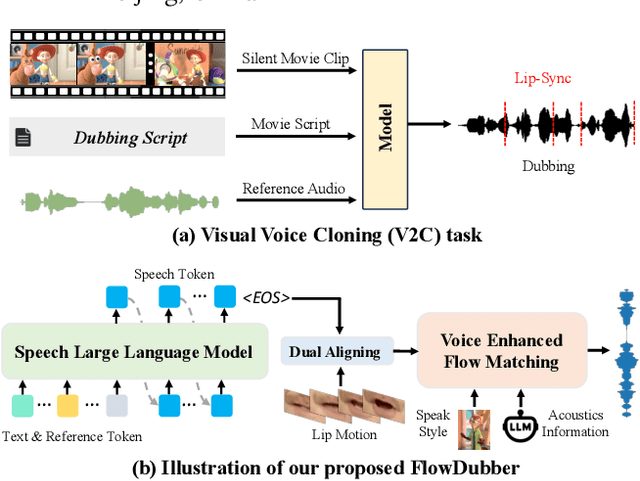

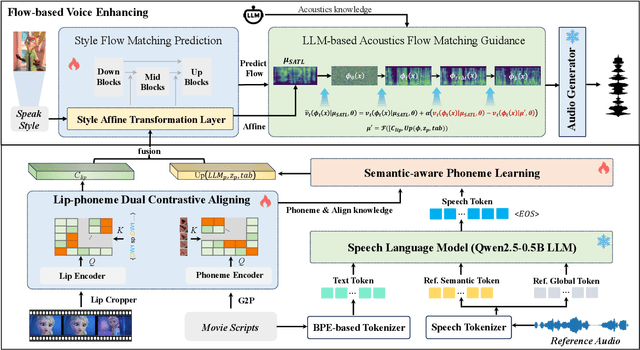

Abstract:Movie Dubbing aims to convert scripts into speeches that align with the given movie clip in both temporal and emotional aspects while preserving the vocal timbre of a given brief reference audio. Existing methods focus primarily on reducing the word error rate while ignoring the importance of lip-sync and acoustic quality. To address these issues, we propose a large language model (LLM) based flow matching architecture for dubbing, named FlowDubber, which achieves high-quality audio-visual sync and pronunciation by incorporating a large speech language model and dual contrastive aligning while achieving better acoustic quality via the proposed voice-enhanced flow matching than previous works. First, we introduce Qwen2.5 as the backbone of LLM to learn the in-context sequence from movie scripts and reference audio. Then, the proposed semantic-aware learning focuses on capturing LLM semantic knowledge at the phoneme level. Next, dual contrastive aligning (DCA) boosts mutual alignment with lip movement, reducing ambiguities where similar phonemes might be confused. Finally, the proposed Flow-based Voice Enhancing (FVE) improves acoustic quality in two aspects, which introduces an LLM-based acoustics flow matching guidance to strengthen clarity and uses affine style prior to enhance identity when recovering noise into mel-spectrograms via gradient vector field prediction. Extensive experiments demonstrate that our method outperforms several state-of-the-art methods on two primary benchmarks. The demos are available at {\href{https://galaxycong.github.io/LLM-Flow-Dubber/}{\textcolor{red}{https://galaxycong.github.io/LLM-Flow-Dubber/}}}.
ProgRoCC: A Progressive Approach to Rough Crowd Counting
Apr 18, 2025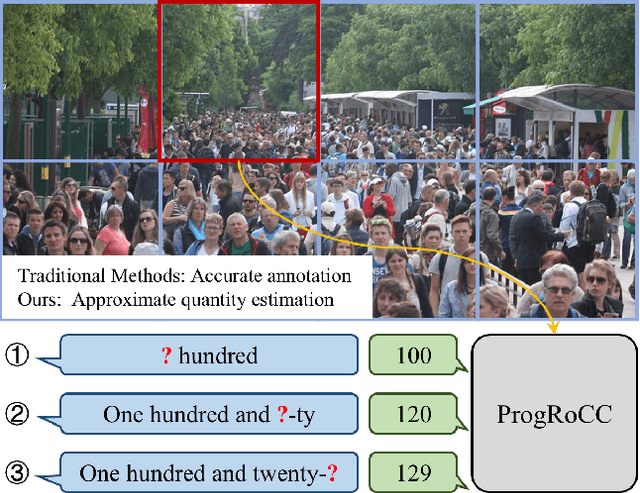
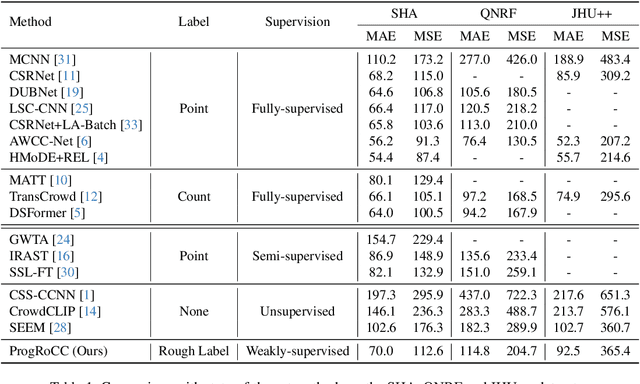
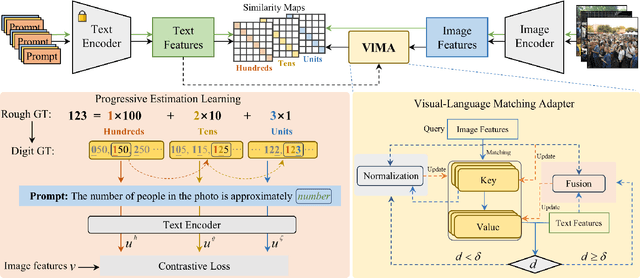

Abstract:As the number of individuals in a crowd grows, enumeration-based techniques become increasingly infeasible and their estimates increasingly unreliable. We propose instead an estimation-based version of the problem: we label Rough Crowd Counting that delivers better accuracy on the basis of training data that is easier to acquire. Rough crowd counting requires only rough annotations of the number of targets in an image, instead of the more traditional, and far more expensive, per-target annotations. We propose an approach to the rough crowd counting problem based on CLIP, termed ProgRoCC. Specifically, we introduce a progressive estimation learning strategy that determines the object count through a coarse-to-fine approach. This approach delivers answers quickly, outperforms the state-of-the-art in semi- and weakly-supervised crowd counting. In addition, we design a vision-language matching adapter that optimizes key-value pairs by mining effective matches of two modalities to refine the visual features, thereby improving the final performance. Extensive experimental results on three widely adopted crowd counting datasets demonstrate the effectiveness of our method.
Negate or Embrace: On How Misalignment Shapes Multimodal Representation Learning
Apr 16, 2025
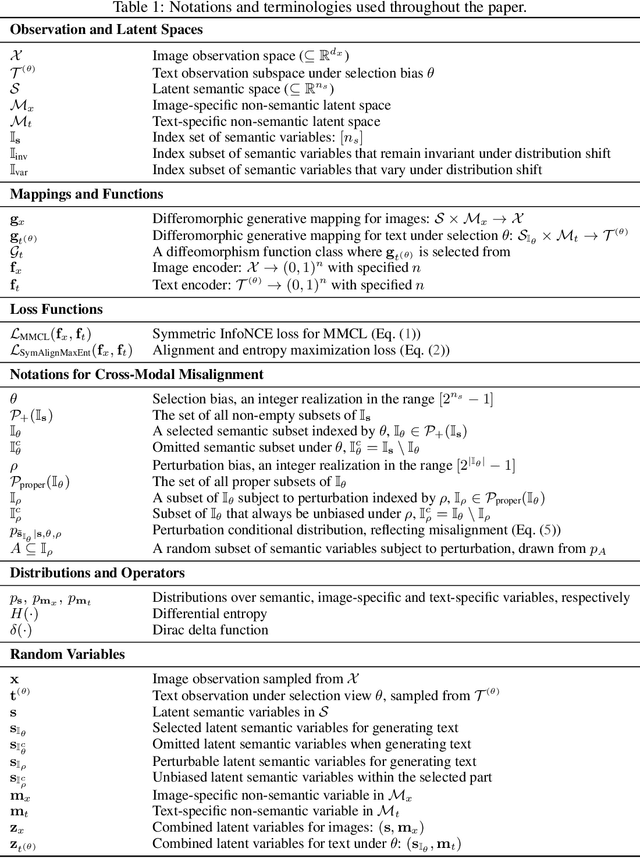
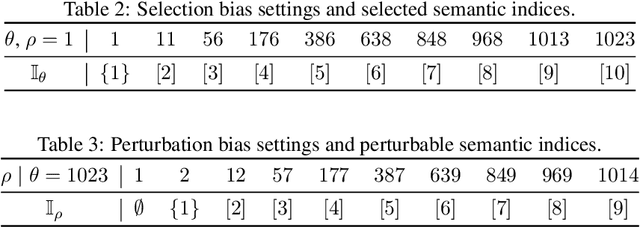

Abstract:Multimodal representation learning, exemplified by multimodal contrastive learning (MMCL) using image-text pairs, aims to learn powerful representations by aligning cues across modalities. This approach relies on the core assumption that the exemplar image-text pairs constitute two representations of an identical concept. However, recent research has revealed that real-world datasets often exhibit misalignment. There are two distinct viewpoints on how to address this issue: one suggests mitigating the misalignment, and the other leveraging it. We seek here to reconcile these seemingly opposing perspectives, and to provide a practical guide for practitioners. Using latent variable models we thus formalize misalignment by introducing two specific mechanisms: selection bias, where some semantic variables are missing, and perturbation bias, where semantic variables are distorted -- both affecting latent variables shared across modalities. Our theoretical analysis demonstrates that, under mild assumptions, the representations learned by MMCL capture exactly the information related to the subset of the semantic variables invariant to selection and perturbation biases. This provides a unified perspective for understanding misalignment. Based on this, we further offer actionable insights into how misalignment should inform the design of real-world ML systems. We validate our theoretical findings through extensive empirical studies on both synthetic data and real image-text datasets, shedding light on the nuanced impact of misalignment on multimodal representation learning.
The Devil is in the Distributions: Explicit Modeling of Scene Content is Key in Zero-Shot Video Captioning
Mar 31, 2025


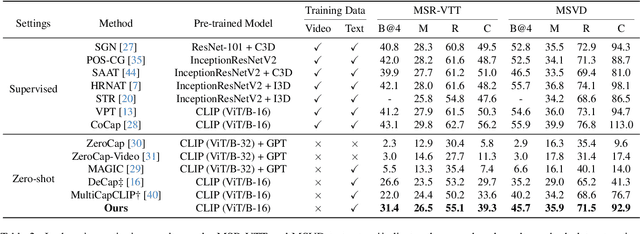
Abstract:Zero-shot video captioning requires that a model generate high-quality captions without human-annotated video-text pairs for training. State-of-the-art approaches to the problem leverage CLIP to extract visual-relevant textual prompts to guide language models in generating captions. These methods tend to focus on one key aspect of the scene and build a caption that ignores the rest of the visual input. To address this issue, and generate more accurate and complete captions, we propose a novel progressive multi-granularity textual prompting strategy for zero-shot video captioning. Our approach constructs three distinct memory banks, encompassing noun phrases, scene graphs of noun phrases, and entire sentences. Moreover, we introduce a category-aware retrieval mechanism that models the distribution of natural language surrounding the specific topics in question. Extensive experiments demonstrate the effectiveness of our method with 5.7%, 16.2%, and 3.4% improvements in terms of the main metric CIDEr on MSR-VTT, MSVD, and VATEX benchmarks compared to existing state-of-the-art.
MATHGLANCE: Multimodal Large Language Models Do Not Know Where to Look in Mathematical Diagrams
Mar 26, 2025Abstract:Diagrams serve as a fundamental form of visual language, representing complex concepts and their inter-relationships through structured symbols, shapes, and spatial arrangements. Unlike natural images, their inherently symbolic and abstract nature poses significant challenges for Multimodal Large Language Models (MLLMs). However, current benchmarks conflate perceptual and reasoning tasks, making it difficult to assess whether MLLMs genuinely understand mathematical diagrams beyond superficial pattern recognition. To address this gap, we introduce MATHGLANCE, a benchmark specifically designed to isolate and evaluate mathematical perception in MLLMs. MATHGLANCE comprises 1.2K images and 1.6K carefully curated questions spanning four perception tasks: shape classification, object counting, relationship identification, and object grounding, covering diverse domains including plane geometry, solid geometry, and graphical representations. Our evaluation of MLLMs reveals that their ability to understand diagrams is notably limited, particularly in fine-grained grounding tasks. In response, we construct GeoPeP, a perception-oriented dataset of 200K structured geometry image-text pairs explicitly annotated with geometric primitives and precise spatial relationships. Training MLLM on GeoPeP leads to significant gains in perceptual accuracy, which in turn substantially improves mathematical reasoning. Our benchmark and dataset establish critical standards for evaluating and advancing multimodal mathematical understanding, providing valuable resources and insights to foster future MLLM research.
 Add to Chrome
Add to Chrome Add to Firefox
Add to Firefox Add to Edge
Add to Edge